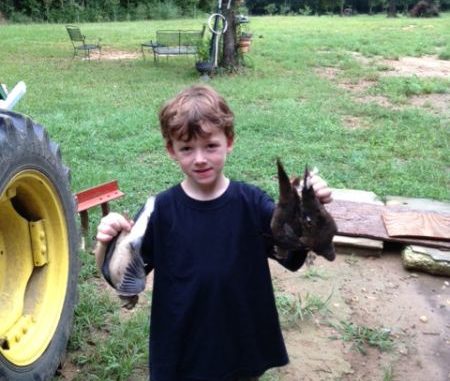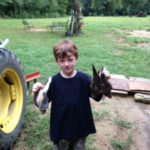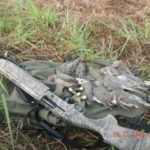
The first shots of the new season have been fired; now it is time to share our harvest with those who have needs.
During the second week of the teal season in September, I was up in Desoto Parish checking deer feeders and getting the duck feeder ready for migrating waterfowl. I was on the big lake early, chunking a Ribbet frog when I heard the old, familiar sound of a small jet plane soaring overhead.
It was too dark to see it, but I knew what it was; once you hear the sound of a flight of ducks zooming overhead you never forget it.
As light began to chase away the darkness I soon saw what had buzzed over me: a small flight of blue-winged teal, crisscrossing over the water as the birds searched for a place to land and feed.
This group eventually settled down, but the sky was busy with a few more small flights buzzing around looking for breakfast. Had I been teal hunting, I believe I might had been able to get my limit on this small north Louisiana lake.
I sat in the pirogue remembering back many years when Dad and I read about a new duck season for teal in September; it was in the late ’60s, and the new teal season was being promoted in the Louisiana Conservationist. We sent in our names and info, and LDWF sent us back teal hunting permits.
Now, Lake Bistineau was not a Mecca for teal, but it did give us a chance to be out duck hunting.
This season has become a permanent fixture in the annual hunting season.
In September, I made a few dove hunts in the fields I had prepared back in April and had been manicuring the weeks prior to Sept. 5. Dr. Barry Steele and my friend Ken Mason joined me for a morning hunt up the road from our property, and the three of us bagged 15 — not great, but it was fun and gave us time in the field to re-create ourselves.
I took grandson William on the property later that afternoon. It was his first dove hunt, and it gave me time to introduce the 5-year-old to the sport of wing shooting. I grew up dove hunting, and it has always been an important time for me.
I suppose you could say it was a typical hunt with a 5-year-old.
“Chief, what does a dove look like? Chief are you going to shoot that bird? Chief look at that big bird; shoot it! Why is that bird making that noise? You need to shoot it. What about those little birds; are those doves?”
Question after question came shooting out of the youngster’s mouth. I tried to answer as best I could. A dove is gray, has a pointed tail and head, small jet wings, and flies smooth and fast. No, those are blue jays; see how they flap their wings when they fly? Doves fly better than that. That is a buzzard: They eat the dead animals on the road; we like them. That is a pileated woodpecker making that awful noise, and we probably should shoot it but we never shoot them; it is against the law. Those little birds are our bluebirds, and we never, ever shoot them.
Finally three doves came sailing by to our right. I raised up and fired twice, and somehow two doves floated down.
Then William started the questions again. What part do we eat? How do you clean it? What are you going to do with the feathers?
I heard doves and, as we looked up, two more came sailing overhead — bam, bam!
This time only one hit the ground.
It was a great afternoon with William, and one that he probably will remember for a while. The September season provides opportunity to spend time with friends and loved ones, especially the youngsters who, after all, are the future of hunting.
Speaking of which, the 2015 Youth Hunter of the Year program gets into full gear with the fall seasons. This program is designed specifically for youth hunters (15 years old or younger) and is by the Louisiana Department of Wildlife and Fisheries and the Louisiana Outdoor Writers Association.
Youth hunters simply have to write a story about a hunting adventure and submit it, along with some photographs. The story should tell about the hunt in general — the good things and bad things — and particularly what the young hunter enjoyed.
It is not a contest about killing a big buck or turkey or a limit of ducks; it is an opportunity for young hunters to simply tell a story about spending time in the great outdoors with family and friends The program is designed to help keep the hunting tradition alive in families across the Bayou State.
If you are interested in finding out more, check out the program on the LDWF or LOWA websites.
Deadline for submitting stories is June 30, 2016. Winners will be recognized at the annual Louisiana Outdoor Writers Conference in August.
In September, hunters also had the opportunity to clean out their freezer and share with needy families through the. Hunters for the Hungry Freezer Days. I helped with the event for the Greater Baton Rouge Area Food Bank, and we had another successful day.
During the 2015 deer season, hunters can continue to share their harvest through the Hunters for the Hungry Donate a Deer Program. There are numerous meat processors located around the state at which hunters can donate deer and have it processed for the food banks at no cost to the hunter.
It is asked that hunters field dress deer before dropping them off at the processing facility. For a list of parishes with meat processors participating in the program go to www.hunters4hungrylouisiana.org.
Hunters should also be aware that most local food banks will gladly accept fish and game donations during the season.
Giving to others what we have been blessed with is something hunters need to do. Hunters have carried the ball for wildlife restoration for decades, so giving back the first fruits of our harvest is only natural.
The motto for Hunters for the Hungry reflects just this: “Hunters who care share.”




